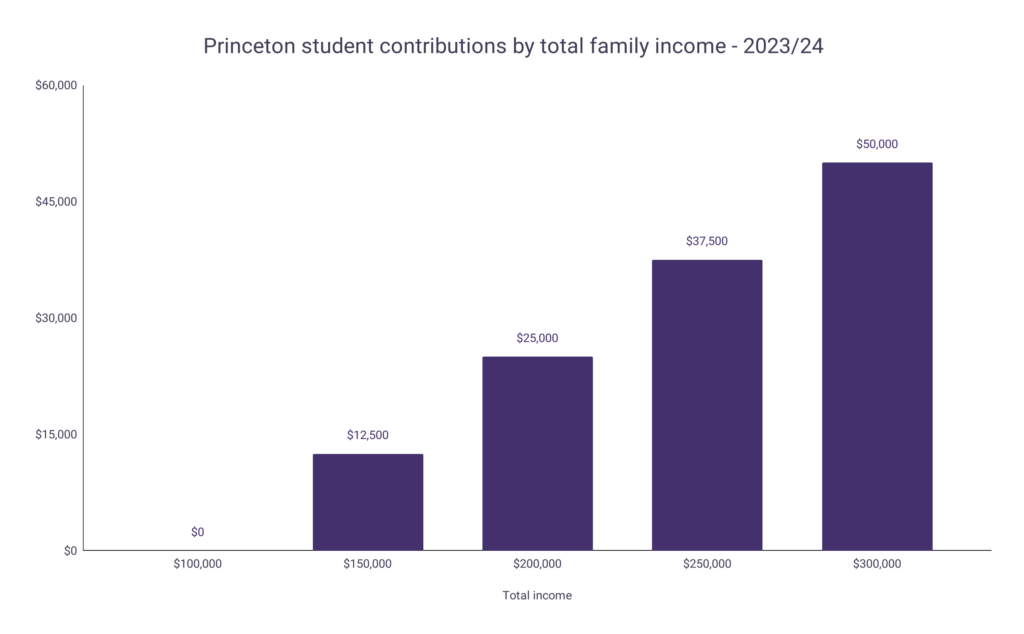This report looks at the cost of private higher education at Princeton University and examines how the type and level of financial aid given can vary between undergraduate and graduate students at the Ivy League institution.
- As of the 2022/23 academic year, Princeton undergraduates and graduates on standard courses can expect tuition fees of $57,410 per year.
- Princeton’s tuition fees have risen by 10.68% over a 4-year period, showing a CAGR of 3.44%.
- In total, Princeton undergraduates studying a standard 4-year course can expect tuition fees of $229,640.
- In total, Princeton graduates studying a standard 2-year course can expect tuition fees of $114,820.
- Health fees for students total $3,000 annually.
- Princeton health fees show a CAGR of 16.45% over a 4-year period.
- Health fees could total $6,000 for a 2-year course or $12,000 for a 4-year course at a minimum (assuming annual price increases).
- As of the 2023/24 academic year most students with family incomes under or equal to $100,000 qualify for full financial aid, covering the entirety of their expenses at Princeton.
Princeton standard tuition fees (full-time courses)
- As of 2022/23, standard undergraduate and graduate tuition fees at Princeton for full-time courses are $57,410.
- Annual tuition fees have risen by $5,540 throughout the given 4-year period.
- They have also risen year-on-year.
- Health fees total $3,000 each year.
- Health fees have risen by $1,100 throughout the given 4-year period.
- They have also risen year-on-year.
| Fee type | 2019/20 | 2020/21 | 2021/22 | 2022/23 | Change |
| Tuition fee | $51,870 | $53,890 | $56,010 | $57,410 | + 10.68% |
| Health fees | $1,900 | $2,580 | $2,780 | $3,000 | + 57.89% |
A graph is given below to show Princeton’s standard tuition fees for full-time courses by year:

Princeton standard stipend rates
- As of the 2022/23 academic year, stipends for university fellowships total $45,600 annually.
- Stipends for first year fellowships total $40,000 annually.
- Stipends for assistantships in research total $40,000 annually.
- Stipends for assistantships in instruction total $42,000 annually.
| Course | 2019/20 | 2020/21 | 2021/22 | 2022/23 | Change |
| University fellowship | $34,425 | $35,500 | $36,570 | $45,600 | 32.46% |
| First year fellowship | $29,900 | $30,800 | $31,720 | $40,000 | 33.78% |
| Assistantship in research | $29,900 | $30,800 | $31,720 | $40,000 | 33.78% |
| Assistantship in instruction | $32,900 | $33,800 | $34,800 | $42,000 | 27.66% |
A graph is given below to show Princeton’s standard stipend rates by year:

Princeton financial aid
Undergraduates
- Princeton students that started during 2021/22 with annual family incomes up to $65,000 receive full tuition, room and board through financial aid.
- Those with annual family incomes up to $160,000 generally do not have to pay for tuition if they receive financial aid.
- 100% of students with annual family incomes up to $180,000 qualify for financial aid.
- At undergraduate level, approximately 62% of students receive financial aid.
- Need-based Federal Pell Grants were available to 22% of entering undergraduates.
- As of the 2021/22 academic year, an estimated 212 million in grants were awarded to over 3,200 undergraduates.
- The average grant was $62,200 for entering undergraduates, intended to cover 100% of tuition fees.
- 83% of seniors graduate debt-free.
- Of seniors that borrow, average student debt at graduation stands at $9,600.
Graduates
- As a general rule, Princeton University Graduate School does not provide funding to master’s candidates.
- Despite this, students may be eligible to undertake assistantships in research or instruction that will provide them with stipends.
- External funding options are also available.
- At Ph.D. level, Princeton will fully fund every degree-seeking candidate.
- Princeton offers tailored support throughout all years of regular Ph.D. program enrollment.
Princeton student contributions by total family income for 2023/24
- As of 2023/24, most students with family incomes under or equal to $100,000 qualify for full financial aid.
- This covers full tuition, room, board, books and personal expenses.
- Students with family incomes of $150,000 are expected to contribute $12,500.
- Students with family incomes of $200,000 are expected to contribute $25,000.
- Students with family incomes of $250,000 are expected to contribute $37,500.
- Students with family incomes of $300,000 are expected to contribute $50,000.
| Family income | Total student contribution |
| Less than or equal to $100,000 | $0 |
| $150,000 | $12,500 |
| $200,000 | $25,000 |
| $250,000 | $37,500 |
| $300,000 | $50,000 |
A graph is given below to show expected student contributions by total family income for the Princeton 2023/24 academic year:

Princeton tuition fees FAQ
Should Princeton students reapply for financial aid annually?
- For each year that a student wishes to attend Princeton, a new application for financial aid must be submitted.
How does Princeton decide recipients of financial aid?
- Princeton decides recipients of financial aid by need only.
- Information supplied on a student’s financial aid application and supporting evidence will determine how much support is provided.
Does financial aid affect Princeton admissions?
- Financial aid does not affect the Princeton admission process.
- In order to ensure equality of opportunity, Princeton operates with a need-blind admission policy.
- This helps students that cannot afford the full cost of attendance and covers all admission applicants.
Can international students receive financial aid at Princeton?
- International students at Princeton can receive financial aid.
- Princeton’s policy of meeting the full financial needs of its students applies to all university admissions, regardless of a student’s citizenship status.

